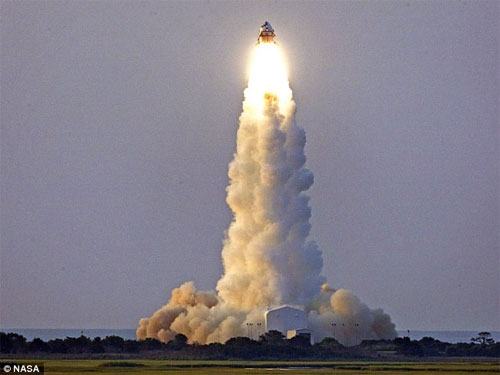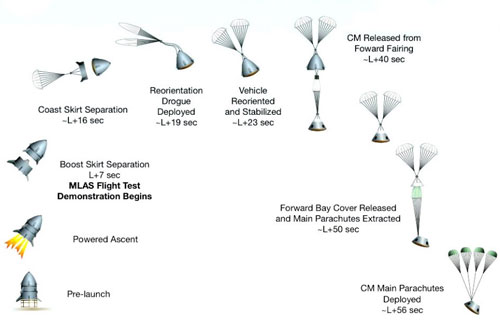NASA tested the new launch system
NASA has succeeded in testing a new destroyer system that helps astronauts fall by parachute safely when a missile launch occurs.
The astronauts probably had a bit of fear during the rocket launch. Don't worry, when 1 million gallons of fuel are exploding under their seats during take-off. But now they can breathe a sigh of relief because NASA has succeeded in testing an escape cover to help them safely fall down with parachutes when disaster strikes.
A 30m spacecraft was tested at NASA's Wallops Island Facility launch area in Virginia on June 9. After climbing to an altitude of 7,000 feet, an automated vehicle operation from the ship landed safely on the Pacific Ocean with the aid of 9 parachutes and 16 rocket engines.

MLAS test (Photo: NASA)
NASA built a system called 33-foot Max Launch Abort System (MLAS) , named after Maxim Farget, designer of Project Mercury Capsule in the early 1960s and also the inventor of the launch pad.
MLAS system will be activated if an emergency situation occurs including when the missile is still on the launch pad. Four powerful missile launcher engines will operate and push the vehicle weighing 46,000lb (libra, 1lb = 453.6g) away from the main missile. After 7 seconds the motors will split and 9 seconds later, the motors attached to the split-phase missiles are also separated from the missiles.
The head carries a scientific device with the astronauts inside will be guided and slowed down with the help of parachutes. The compartment contains people after being released from the rocket's head, its 4 parachutes will pop out. Astronauts will float in space and safely land. The whole process is complicated in less than 1 minute.

MLAS system model (Photo: NASA)
The MLAS system was created to replace the Orion launcher system and will be used for the crew of NASA's Orion space exploration ship.
The Orion spacecraft is expected to be launched on the ISS international space station in 2015, five years after the space shuttle stops working. It is hoped that it will then take the next generation of astronauts to the moon to live and work.
While MLAS has not yet been planned to replace the Orion annihilation system, it will help engineers gain experience in testing spacecraft and elicit new ideas for designing multiple directions. more dynamic gas.
The Orion is built on the technical principles established during the shuttle and Apollo program, but incorporates the latest technologies.
When Apollo 11 landed on the moon 40 years ago, it was the first computer in the world to integrate microchips and could only operate under a well-defined program.

Photos of MLAS (Photo: NASA)
- NASA has successfully tested the most powerful rocket on the planet
- NASA tested the new proton engine system for spacecraft
- Technologies that help NASA conquer Mars
- NASA sends a spaceship to carry soil
- NASA will launch the probe into the Sun in 2018
- The astronaut rescue system if the rocket explodes
- Announced the latest super rocket generation
- America is about to launch a train to the toilet
- America announced the design of missiles to send people to Mars
- US tests super-powerful missiles
- NASA launched two satellites to probe the radiation belt
- NASA moved a billion-dollar spacecraft flight schedule
 Van Allen's belt and evidence that the Apollo 11 mission to the Moon was myth
Van Allen's belt and evidence that the Apollo 11 mission to the Moon was myth The levels of civilization in the universe (Kardashev scale)
The levels of civilization in the universe (Kardashev scale) Today Mars, the sun and the Earth are aligned
Today Mars, the sun and the Earth are aligned The Amazon owner announced a secret plan to build a space base for thousands of people
The Amazon owner announced a secret plan to build a space base for thousands of people